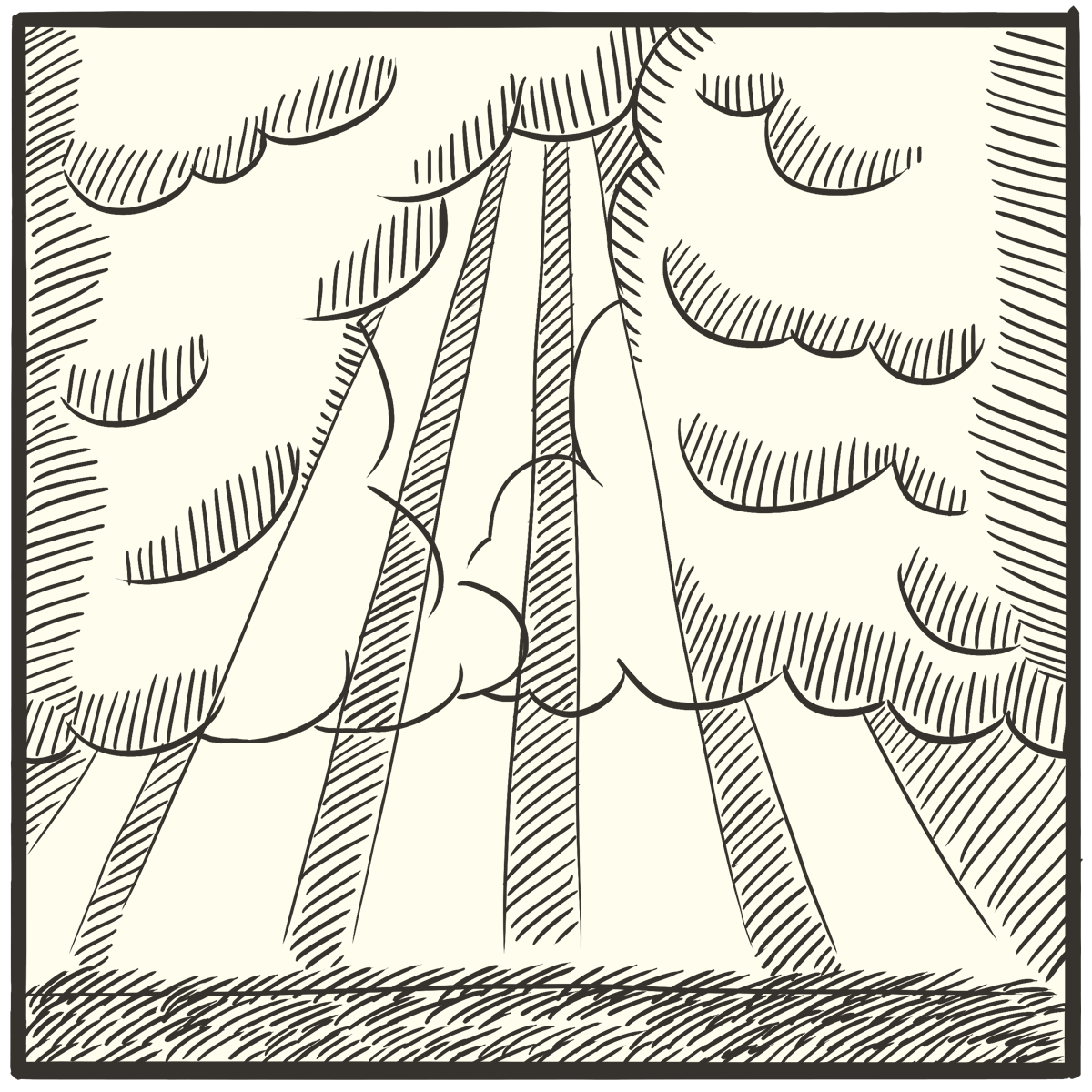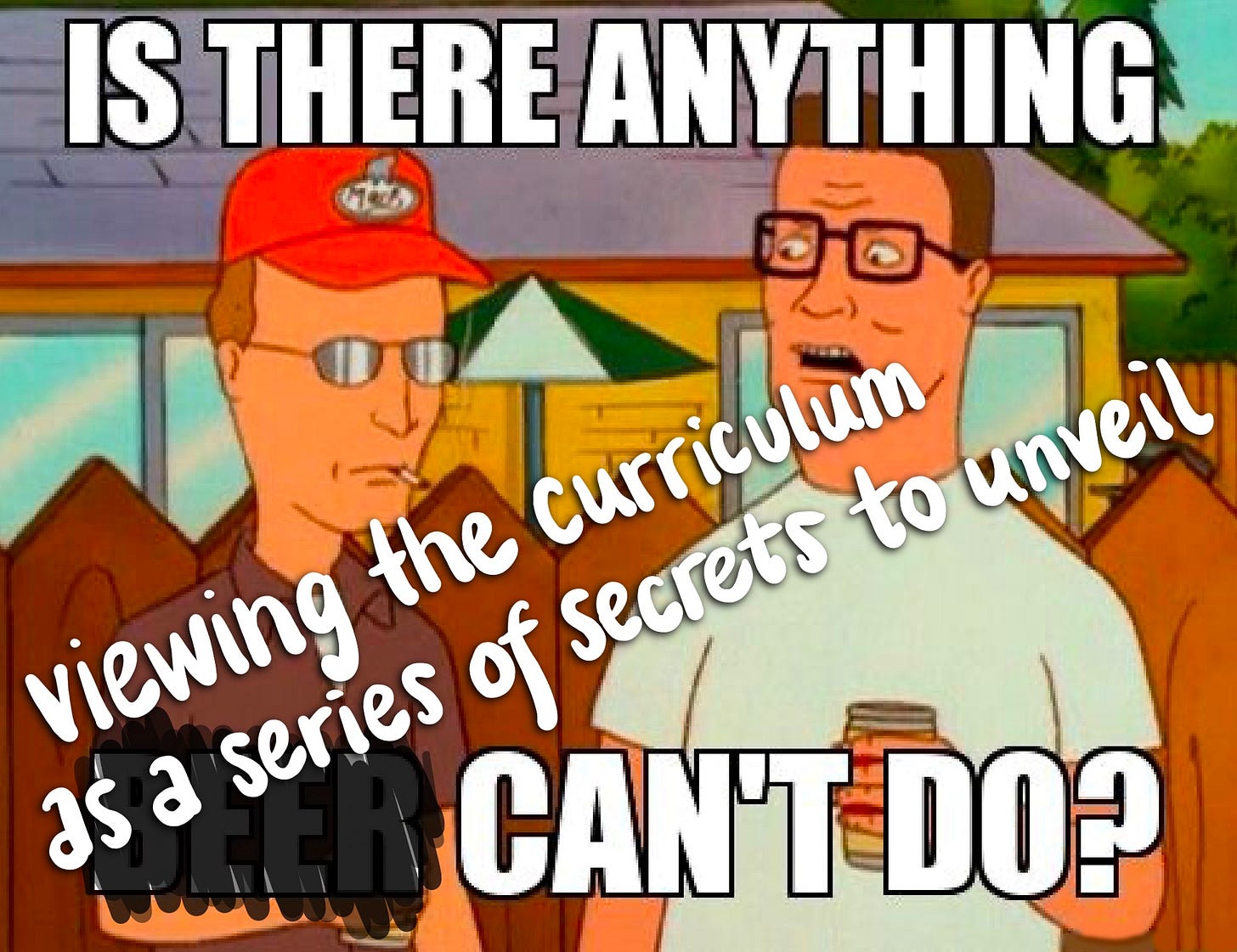1. A problem
“In schools, we represent the world to children
as mostly known
and rather dull.The opposite is the case:
we are surrounded by mystery,
and what we know is fascinating.”–Kieran Egan, interviewed on rorotoko.com
2. Basic plan
Build each science lesson around something that upends how students see the world, and throws them into wonder. Make that the end of the lesson, and for the love of God, DON’T JUST TELL THEM IT.
Instead, treat it as a secret. Make the class work to understand it. When they finally do — when it finally makes sense to them — it will feel like a revelation, like an epiphany, like a visit from the gods themselves. They’ll remember it; they’ll tell their parents about it; they’ll keep asking about it to understand it better.
3. What you might see
Students’ eyes going wide and jaws dropping as they realize that…
teenagers smell bad because sweat is literally ▮▮▮▮, and that it curdles into ▮▮▮▮▮▮ ▮▮▮▮▮▮
trees are heavy because they’re made out of human ▮▮▮▮▮▮
inside every pinch of dirt is a ▮▮▮▮▮▮▮▮ of billions of ▮▮▮▮▮▮▮s
the dark splotches on the Moon are puddles of ▮▮▮▮ filled with ▮▮▮▮▮▮s
the island of Manhattan is really just pieces of ▮▮▮▮▮▮ shoved by ▮▮▮▮ squishing itself ▮▮▮▮▮▮▮▮
And, finally, that…
the last time you smelled apple pie, ▮▮▮ing ▮▮▮▮▮▮▮▮s of pie were entering your ▮▮▮▮ and getting caught in your ▮▮▮▮▮▮▮▮s, because YOU ARE LITERALLY A ▮▮▮▮▮ TRAPPED IN A ▮▮▮!
See what I did there? I’M GONNA MAKE YOU EARN IT! For the first 24 hours on this post, I’ll be opening comments up to everyone. Make your guesses; at the end of Saturday, I’ll share the answers. (In general, commenting on these weekly pattern language posts is a perk for paid subscribers, but you can become one for just $5/month.) (Oh, if your family KNOWS the answers because you were in one of my Science is WEIRD courses, please don’t ruin it for others.)
4. Why?
Science has been blowing people’s minds since its birth around 600 BCE. It’s a machine for uncovering the hidden truth of the world — the patterns that weren’t designed to fit snugly inside our minds, and so went unglimpsed by people for the eons since we’ve been able to talk.
Yet after hundreds of years of reform efforts, science classes still come across to most people piles of finicky details.
This is a tragedy. And it contributes to the low view so many people have of science — to be honored in the abstract, but to be ignored whenever it clashes with an actual belief about the world. (This is true of every community.1)
If we got a society genuinely excited about science — and open to reconsidering beliefs about the world — it seems like that could be big.
5. Egan’s insight
Where do we see this in the human experience?
Hiding your light under a bushel — and making noobs work hard before you unveil it — is actually a pretty common practice through history.
Shamans did it. The alchemists and Kabbalists did it. Jesus did it. The Freemasons still do it.
Human minds link scarcity to value: if these scientists are making their discoveries public, and if teachers want everyone to know something, well — it must not be that important!
How might this build different kinds of understanding?
Egan would suggest that the lust for secret knowledge is a thread that runs through every kind of understanding, though it morphs as it goes.
In SOMATIC understanding, we’re pulled toward 🤸♀️FINDING PATTERNS and excited when we find 🤸♀️INCONGRUITY.2 MYTHIC understanding gives us general models of the world, and when ours is broken, we see it as 🧙♂️MAGIC and 🧙♂️MYSTERY.
ROMANTIC understanding becomes obsessed with these barriers, and when they stubbornly refuse to go away, experiences them as 🦹♂️WONDER and 🦹♂️AWE.3
All these are what power the PHILOSOPHIC thing we’re trying to get students to engage in — the 👩🔬SEARCH FOR TRUTH.
What are these funny symbols, you ask?
At the heart of Egan’s understanding of education is the notion that, for humans, certain practices and formats of information are special. Egan calls them “tools”, because throughout history, cultures have used them to pass themselves down. He groups them into five “toolkits” — SOMATIC (🤸♀️), MYTHIC (🧙♂️), ROMANTIC (🦹♂️), PHILOSOPHIC (👩🔬), and IRONIC (😏).
6. This might be especially powerful for…
Intellectual thrill junkies. People who’d otherwise be prey for crap conspiracy theory shows on The History Channel. People who use the 🤯 emoji unironically.
7. How could this go wrong?
Some kids just want the facts, please, now
I’ve had one very gifted kid — two? — who’ve not enjoyed having the revelation held back. My instinctual reaction is “eat your #%@^ vegetables!” But maybe there’s something in this that we should pay attention to.
Kids pass along the secrets to younger siblings
This webcomic neatly summarizes my perspective on this.
…and then those younger siblings blurt it out, spoiling the class
When I have a hunch that a kid knows an answer ahead of time, I ask for their guesses privately. If they actually know it, I ask them to keep it secret until the end of class.
But the bigger strategy to minimize this is to disincentivize it by not putting any external prize on knowing the answer. “The journey is more important than the destination”, and all that.
Can you think of another way this could go wrong… or, um, a way to help avoid that? Become a paid subscriber and join in the comments conversation!
8. Classroom setup
—
9. Similar stuff (others are doing)
Hat tip to Eliezer Yudkowsky for putting this so succinctly.
I mean, right now, people can study science but they don’t.
“Scarcity”, it’s called in social psychology. What appears to be in limited supply, is more highly valued. And this effect is especially strong with information—we’re much more likely to try to obtain information that we believe is secret, and to value it more when we do obtain it.
With science, I think, people assume that if the information is freely available, it must not be important. So instead people join cults that have the sense to keep their Great Truths secret. The Great Truth may actually be gibberish, but it’s more satisfying than coherent science, because it’s secret.
Science is the great Purloined Letter of our times, left out in the open and ignored.
– Eliezer Yudkowsky, “To Spread Science, Keep it Secret”
10. Open questions
Q: How much of the science curriculum should be given as secrets?
I’ve built Science is WEIRD on Secrets & Revelations;4 this works great for the late-elementary-through-high-school ages.
I’m not sure if it’s necessary for lower elementary school. The exciting facts of the world5 sometimes seem like they’re more than enough. And the early years are rife for building other aspects of SOMATIC understanding.
And what other aspects of late-elementary-through-high-school science curriculum should be forms other than secrets & revelations?
I don’t know.
Q: What other subjects should be given as secrets?
SO. MANY.
This last summer I found out that subjects which can be taught using secrets & revelations include…
math (I created a course on the origins of algebra)
grammar (I created a course on the epic of punctuation)
psychology (okay, that’s a science, but I created a course on how “hyperfocus” works, and how to use it)
11. How could this be done small, now?
This, as mentioned, is the secret sauce of Science is WEIRD. But if you want to try this on your own…
take something cool that you learned about science lately
figure out a question it’s the answer to
ask someone that question
See what happens!
12. Related patterns
Secrets and Revelations° in science is similar to the Boss Questions° in math, except here they’re at the heart of the lesson. It benefits from Metaphors before Definitions°. A great way to gin up the emotions (and to teach a lot of science) is A Riddle Wrapped in a Game°. Students can write the answers in a DIY Textbook°.
Afterword: Going full-meta, here
I’m really interested to see what you guess for the missing words above! (If it’s any help, each black rectangle is a letter.)
Except yours, obviously.
I think this is what new-parent-of-two Scott Alexander is talking about when he refers to his twins as “surprisal-minimization engines”.
Why are “wonder” and “awe” listed as two separate things, you ask? Egan uses those terms to point to two different things. “Wonder” refers to things that touch the limit of what we can do or understand. (Think Michael Jordan dunking, or the number of stars in the observable universe.) “Awe” refers to things that transcend that limit.
Peter Thiel might say that my secret is secrets!
Did you know that the largest land mammal could have rested its chin on a third story window?







Behold, the revelations!
1. Teenagers smell bad because sweat is literally MILK, and that it curdles into STINKY CHEESE. (Fun fact: milk is an evolutionary modification of sweat, which already includes fats to keep skin waterproof. The microbe that turns cow milk into Limberger cheese also calls your skin home; what you’re smelling in a teenager’s old clothes are LITERALLY molecules of cheese.)
2. Trees are heavy because they’re made out of human BREATH. (Though trees are brown, they’re not made of dirt — they’re made of air! You breathe out carbon dioxide molecules — C+O+O. Trees suck them in, rip them apart, breathe out the O+O, and keep the C’s for themselves. This is what scientists call “the carbon cycle”.)
3. Inside every pinch of dirt is a ZOOTOPIA of billions of ANIMALs. (Thousands of species; billions of individuals.)
4. The dark splotches on the Moon are puddles of LAVA filled with TUNNELs. (We haven’t known about the lava for all that long, but if you know the lava tubes of Hawaii… yeah, the Moon has those, too. Big ones. So big, we might be able to build cities in ‘em.)
5. The island of Manhattan is really just pieces of CANADA shoved by SNOW squishing itself DOWNHILL. (Not so long ago, it snowed and snowed and snowed in Canada and never melted. This snow squeezed down into ice, and it was so heavy that it slid downhill toward the Atlantic ocean. As it slid, it ripped up the Canadian landscape, down to the bedrock — which is why large regions of Canada have no fossils. Those boulders piled up… and made Manhattan!)
6. The last time you smelled apple pie, FLYing MOLECULEs of pie were entering your NOSE and getting caught in your TENTACLEs, because YOU ARE LITERALLY A BRAIN TRAPPED IN A JAR! (There’s probably too much to unpack here, but note that when we say “volatile chemicals” we mean “molecules that are small enough to get mixed up in the air”. Note too that a SMELL of an object isn’t different from the object — it’s tiny parts of the object floating away. You smell them when they enter your nasal cavity and get stuck at the top in the “olfactory epithelium” [smell skin], right behind your eyes and under your brain. And, indeed, the neurons dangling down in your olfactory epithelium are best understood as your brain itself — it’s the one spot that your brain enters the outside world. Other than that, your brain — that is, you — spend all its life inside of your skull.)
Congrats to everyone who got some of those right!
I think Section 11 is getting at something very deep here: many things we'd teach as facts in a more traditional school are in fact [1] answers to questions - questions that some people at some point cared a lot about. One way schooling can become boring is just teaching an answer without any indication what question it's the answer to, or even why anyone would care.
A great example of "What is the question?" for chemistry is Oliver Sacks' autobiographical book Uncle Tungsten, going through most of what was in my school chemistry curriculum (with some physics thrown in) but looking at the questions and the people asking them from the point of view of an inquisitive child. And yes, most of the discoveries came from people trying to uncover the secrets of the world. How can a chunk of radium just boil water when that violates everything we know about conservation of energy?
(It's also a recollection of a time when even children could buy highly dangerous chemicals at the local store - in one episode, young Sacks accidentally creates a large quantity of what's essentially poison gas in the house and his parents' reaction is not "Never do that again" but more like "We'll buy you a fume cupboard for your next experiments. Also, could you try using a slightly smaller quantity of hydrochloric acid?")
By the way, for the trees one, I'm guessing "human BREATH", as a metaphor for CO2.
[1] pun sort of intended.